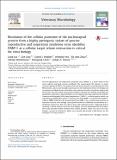Files in this item
Resolution of the cellular proteome of the nucleocapsid protein from a highly pathogenic isolate of porcine reproductive and respiratory syndrome virus identifies PARP-1 as a cellular target whose interaction is critical for virus biology
Item metadata
| dc.contributor.author | Liu, Long | |
| dc.contributor.author | Lear, Zoe | |
| dc.contributor.author | Hughes, David J | |
| dc.contributor.author | Wu, Weining | |
| dc.contributor.author | Zhou, En-Min | |
| dc.contributor.author | Whitehouse, Adrian | |
| dc.contributor.author | Chen, Hongying | |
| dc.contributor.author | Hiscox, Julian A | |
| dc.date.accessioned | 2015-07-15T15:10:02Z | |
| dc.date.available | 2015-07-15T15:10:02Z | |
| dc.date.issued | 2015-03-23 | |
| dc.identifier | 164146164 | |
| dc.identifier | 047d9d19-4153-45c3-b01f-2f7c0b875f57 | |
| dc.identifier | 25614100 | |
| dc.identifier | 84922936239 | |
| dc.identifier.citation | Liu , L , Lear , Z , Hughes , D J , Wu , W , Zhou , E-M , Whitehouse , A , Chen , H & Hiscox , J A 2015 , ' Resolution of the cellular proteome of the nucleocapsid protein from a highly pathogenic isolate of porcine reproductive and respiratory syndrome virus identifies PARP-1 as a cellular target whose interaction is critical for virus biology ' , Veterinary Microbiology , vol. 176 , no. 1-2 , pp. 109-119 . https://doi.org/10.1016/j.vetmic.2014.11.023 | en |
| dc.identifier.issn | 0378-1135 | |
| dc.identifier.other | ORCID: /0000-0002-0090-5710/work/39632386 | |
| dc.identifier.uri | https://hdl.handle.net/10023/6993 | |
| dc.description | Z.L. is funded through a Wellcome Trust PhD grant to A.W. and H.C. is supported by the Fundamental Research Funds for the Central Universities (QN2011065). | en |
| dc.description.abstract | Porcine reproductive and respiratory syndrome virus (PRRSV) is a major threat to the swine industry and food security worldwide. The nucleocapsid (N) protein is a major structural protein of PRRSV. The primary function of this protein is to encapsidate the viral RNA genome, and it is also thought to participate in the modulation of host cell biology and recruitment of cellular factors to facilitate virus infection. In order to the better understand these latter roles the cellular interactome of PRRSV N protein was defined using label free quantitative proteomics. This identified several cellular factors that could interact with the N protein including poly [ADP-ribose] polymerase 1 (PARP-1), a cellular protein, which can add adenosine diphosphate ribose to a protein. Use of the PARP-1 small molecule inhibitor, 3-AB, in PRRSV infected cells demonstrated that PARP-1 was required and acted as an enhancer factor for virus biology. Serial growth of PRRSV in different concentrations of 3-AB did not yield viruses that were able to grow with wild type kinetics, suggesting that by targeting a cellular protein crucial for virus biology, resistant phenotypes did not emerge. This study provides further evidence that cellular proteins, which are critical for virus biology, can also be targeted to ablate virus growth and provide a high barrier for the emergence of drug resistance. | |
| dc.format.extent | 10 | |
| dc.format.extent | 1564028 | |
| dc.language.iso | eng | |
| dc.relation.ispartof | Veterinary Microbiology | en |
| dc.subject | PRRSV | en |
| dc.subject | Nucleocapsid | en |
| dc.subject | PARP-1 | en |
| dc.subject | Antivirus | en |
| dc.subject | 3-AB | en |
| dc.subject | Proteome | en |
| dc.subject | QH301 Biology | en |
| dc.subject | QR355 Virology | en |
| dc.subject | NDAS | en |
| dc.subject | SDG 2 - Zero Hunger | en |
| dc.subject.lcc | QH301 | en |
| dc.subject.lcc | QR355 | en |
| dc.title | Resolution of the cellular proteome of the nucleocapsid protein from a highly pathogenic isolate of porcine reproductive and respiratory syndrome virus identifies PARP-1 as a cellular target whose interaction is critical for virus biology | en |
| dc.type | Journal article | en |
| dc.contributor.institution | University of St Andrews. School of Biology | en |
| dc.contributor.institution | University of St Andrews. Biomedical Sciences Research Complex | en |
| dc.identifier.doi | https://doi.org/10.1016/j.vetmic.2014.11.023 | |
| dc.description.status | Peer reviewed | en |
This item appears in the following Collection(s)
Items in the St Andrews Research Repository are protected by copyright, with all rights reserved, unless otherwise indicated.

